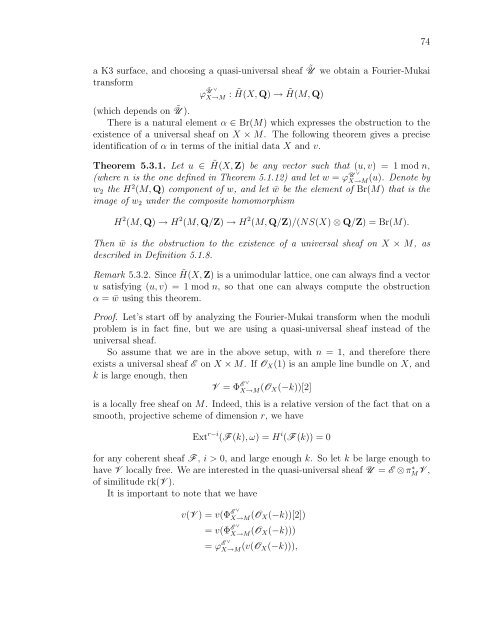derived categories of twisted sheaves on calabi-yau manifolds
derived categories of twisted sheaves on calabi-yau manifolds
derived categories of twisted sheaves on calabi-yau manifolds
You also want an ePaper? Increase the reach of your titles
YUMPU automatically turns print PDFs into web optimized ePapers that Google loves.
a K3 surface, and choosing a quasi-universal sheaf Ũ we obtain a Fourier-Mukai<br />
transform<br />
Ũ ∨<br />
ϕX→M : ˜ H(X, Q) → ˜ H(M, Q)<br />
(which depends <strong>on</strong> Ũ ).<br />
There is a natural element α ∈ Br(M) which expresses the obstructi<strong>on</strong> to the<br />
existence <str<strong>on</strong>g>of</str<strong>on</strong>g> a universal sheaf <strong>on</strong> X × M. The following theorem gives a precise<br />
identificati<strong>on</strong> <str<strong>on</strong>g>of</str<strong>on</strong>g> α in terms <str<strong>on</strong>g>of</str<strong>on</strong>g> the initial data X and v.<br />
Theorem 5.3.1. Let u ∈ ˜ H(X, Z) be any vector such that (u, v) = 1 mod n,<br />
U ∨<br />
(where n is the <strong>on</strong>e defined in Theorem 5.1.12) and let w = ϕX→M (u). Denote by<br />
w2 the H2 (M, Q) comp<strong>on</strong>ent <str<strong>on</strong>g>of</str<strong>on</strong>g> w, and let ¯w be the element <str<strong>on</strong>g>of</str<strong>on</strong>g> Br(M) that is the<br />
image <str<strong>on</strong>g>of</str<strong>on</strong>g> w2 under the composite homomorphism<br />
H 2 (M, Q) → H 2 (M, Q/Z) → H 2 (M, Q/Z)/(NS(X) ⊗ Q/Z) = Br(M).<br />
Then ¯w is the obstructi<strong>on</strong> to the existence <str<strong>on</strong>g>of</str<strong>on</strong>g> a universal sheaf <strong>on</strong> X × M, as<br />
described in Definiti<strong>on</strong> 5.1.8.<br />
Remark 5.3.2. Since ˜ H(X, Z) is a unimodular lattice, <strong>on</strong>e can always find a vector<br />
u satisfying (u, v) = 1 mod n, so that <strong>on</strong>e can always compute the obstructi<strong>on</strong><br />
α = ¯w using this theorem.<br />
Pro<str<strong>on</strong>g>of</str<strong>on</strong>g>. Let’s start <str<strong>on</strong>g>of</str<strong>on</strong>g>f by analyzing the Fourier-Mukai transform when the moduli<br />
problem is in fact fine, but we are using a quasi-universal sheaf instead <str<strong>on</strong>g>of</str<strong>on</strong>g> the<br />
universal sheaf.<br />
So assume that we are in the above setup, with n = 1, and therefore there<br />
exists a universal sheaf E <strong>on</strong> X × M. If OX(1) is an ample line bundle <strong>on</strong> X, and<br />
k is large enough, then<br />
E ∨<br />
V = ΦX→M(OX(−k))[2] is a locally free sheaf <strong>on</strong> M. Indeed, this is a relative versi<strong>on</strong> <str<strong>on</strong>g>of</str<strong>on</strong>g> the fact that <strong>on</strong> a<br />
smooth, projective scheme <str<strong>on</strong>g>of</str<strong>on</strong>g> dimensi<strong>on</strong> r, we have<br />
Ext r−i (F (k), ω) = H i (F (k)) = 0<br />
for any coherent sheaf F , i > 0, and large enough k. So let k be large enough to<br />
have V locally free. We are interested in the quasi-universal sheaf U = E ⊗ π∗ MV ,<br />
<str<strong>on</strong>g>of</str<strong>on</strong>g> similitude rk(V ).<br />
It is important to note that we have<br />
E ∨<br />
v(V ) = v(ΦX→M(OX(−k))[2]) E ∨<br />
= v(ΦX→M(OX(−k))) E ∨<br />
= ϕX→M(v(OX(−k))), 74
















